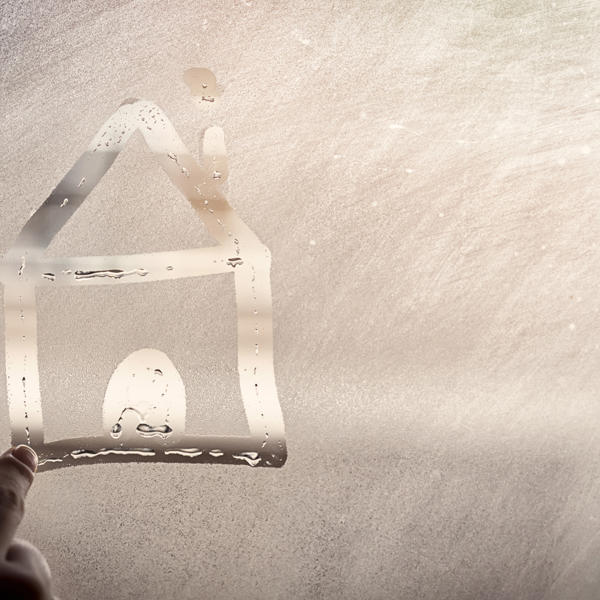Let us know as soon as posisble
If you're experiencing damp or mould in your home it could be a sign you have a leak or that something is wrong that needs fixing so it's important you let us know as quickly as possible so we can help.
0300 123 2221
[email protected]
What is damp?
There are a number of different ways damp can be caused:
Condensation damp
This type of damp is caused by having a significant amount of moisture in the air from a variety of sources such as cooking, bathing, drying clothes etc. It's caused by warm air hitting a cold surface and can often be seen as water on or around your windows, on external walls, in corners or behind furniture.
Penetrating damp
This type of damp is caused by water from outside coming into your home. This could be from a roof leak, broken guttering or chimney, or can soak through the exterior wall. This could be seen as a damp patch on the inside of your home where water has got in.
Plumbing leak damp
This type of damp is caused by a leaking or broken pipe. In some cases you may see puddles of water showing where the leak is, but sometimes the leak could be above the ceiling or under your floor so you might see a damp patch. Plumbing leaks can sometimes be difficult to find where they're hidden, so it may mean we need to find out where the water is coming from before we can put things right.
Rising damp
This type of damp is when water in the ground travels up the wall and into your home. This usually means that the protective layer, known as the damp proof course (DPC) has failed or if the ground level outside, or plants, are higher than the DPC. This is normally seen a damp patch from your floor travelling up the wall showing a 'tide mark' up to 1.5 metres high.
What is mould?
When you see mould growing, it’s a sign that you may have a problem with untreated damp in your home.
Mould might appear black, white, yellow or green in colour. Mould is not only unpleasant to look at but it can increase the risk of asthma and respiratory illnesses in some people and must be dealt with urgently.
If you see mould in your home that you can't wipe away or keeps returning, please contact us straight away.
Please call us on 0300 123 2221
We'll then arrange for the mould to be treated and one of our surveyors will visit your home and carry out an investigation into what caused the mould so we can do what we can to stop it returning.
The guide should help answer your questions and give you more information about what we'll do if you report a problem to us and some indicative timescales, as well as some tips on what you can do yourself.
While we will always try to meet these timescales it will always depend on the cause of the damp or mould and the amount of work we need to do fix things.
-
Damp and Mould Policy
pdf | 6357Kb

How to help reduce condensation in your home
There’s always some moisture in the air, even if you can’t see it. You’ll mostly see the signs of condensation in kitchens and bathrooms normally on windows or external walls but can also be found behind furniture and in the corners of rooms. The moisture is caused from our normal day-to-day activities like washing, cooking, drying clothes on airers or radiators, showering and bathing.
Produce less moisture
- When you're cooking, put your pan lids on as this reduces the amount of steam. Once the water has boiled turn the heat down.
- If you're boiling water to cook vegetables, pasta, rice or potatoes on the hob use the smallest amount of water you can.
- When filling the bath, start with cold water then add the hot. This also helps save your hot water bill.
- If you use a tumble dryer if you can make sure it's the condensing type. If not, make sure the ventilation tube goes outside.
- Don't dry your wet clothes on radiators as this adds extra moisture to the air. Whenever possible dry your clothes outside. If you do have to dry them inside, do it in the bathroom on an airer with the door closed and the window open or extractor fan on.
- Try using a dehumidifier to reduce moisture in the air.
Ventilate your home
Ventilation in a home is important to get rid of extra moisture that is naturally created through day-to-day activities.
- Trickle vents on your windows should always be kept open even in winter. If your windows don't have these try keeping your windows open very slightly. This allows moisture to escape and helps keep the air in your home fresh.
- If you can, open your bathroom and kitchen window after cooking or bathing to release the moisture and steam. Always make sure your extractor fan is working.
- Close the kitchen and bathroom door when you're using them as this helps steam escaping to other parts of your home. Again, open the window if you can.
- If you have the space, don't push your furniture right up against the wall to allow good air flow. We know in some smaller homes this may not be possible.
- Don’t overfill wardrobes and cupboards as this will stop air from circulating. Open the door regularly to let air flow too.
Heat your home
When it gets cold in winter, the chance of you getting condensation in your home increases as we're more likely to have windows closed and be drying laundry inside. When your home is warmer with your heating on, condensation is less likely.
- Have your heating on low and constant, rather than just turning it up high when you need it. This also helps save energy too.
- We know it's expensive but having carpets and curtains in your home will help to keep the warmth in.
- Never use a paraffin or bottled gas heater to heat your home. These are a serious fire risk.
If you're worried about the cost of your heating, please get in touch.
Our specialised teams can help with financial support and budgeting advice to help make sure you're able to heat your home effectively.
Contact us
If you have any concerns, or you have any questions about damp, mould or condensation in your home, then please get in touch.





